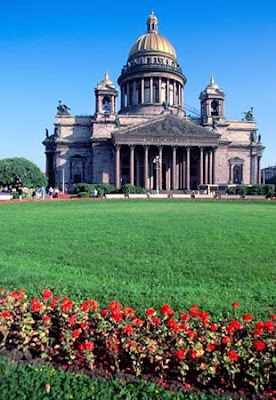Spectacular Cathedrals and Churches
Notre Dame de Paris (Paris)During the 19th century, Notre Dame de Paris was in such a state of disrepair that city planners considered tearing it down. Novelist Victor Hugo, an admirer of the French Gothic structure, wrote “The Hunchback of Notre Dame” to help draw attention to the cathedral’s plight. Success of the book sparked renewed interest in the building and led to a fundraising campaign that financed the cathedral’s 1845 restoration.
St. Patrick’s Cathedral (New York City)
Designed by noted architect James Renwick Jr. in the Gothic Revival style, this New York City cathedral is built of white marble and has an altar designed by Tiffany & Co. The cathedral’s hallmark spires rise 330 feet from the ground. Construction on St. Patrick’s began in 1858; work was halted during the Civil War, resumed in 1865 and was completed in 1878. When the building was dedicated in 1879, its huge proportions dominated the midtown Manhattan of that era.
Hagia Sophia (Istanbul, Turkey)
Famous for its massive dome, the Hagia Sophia is widely considered the best example of Byzantine architecture. It was the largest cathedral in the world for almost 1,000 years until the completion of Spain’s Seville Cathedral in 1520. Originally built as a church between 532 and 537 A.D., Hagia Sophia later became a patriarchal basilica, then a mosque, and is now a museum with rich interior details, including intricate mosaics and marble floor decorations and pillars.
Westminster Abbey (London)
Traditionally the place of coronation and burial for the English monarchy, the Collegiate Church of St. Peter, Westminster, more commonly known as Westminster Abbey, is a mostly Gothic-style church located to the west of the Houses of Parliament. In 1998, Queen Elizabeth II unveiled statues of ten 20th-century Christian martyrs from around the world who are depicted above the abbey’s Great West Door. Among those honored is Nobel Prize-winner the Rev. Martin Luther King Jr.
St. Mark’s Basilica (Venice, Italy)
A prime example of Byzantine architecture, St. Mark’s Basilica is one of Venice’s most famous churches, prominently located on the city’s central St. Mark’s Square. Opulent in design, and boasting gilded Byzantine mosaics, the building once regarded as a status symbol of Venetian wealth and power earned the nickname Chiesa d’Oro (Church of Gold) beginning in the 11th century. Since 1807, the cathedral has been the seat of the Roman Catholic Archdiocese of Venice.
Ebenezer Baptist Church (Atlanta, Georgia)
This Gothic Revival-style church is perhaps best known not only as the headquarters of the Southern Christian Leadership Conference where the Rev. Martin Luther King Jr. worked as a civil rights leader, but also as the home church where King presided as a preacher and where his father, the Rev. Martin Luther King Sr., was pastor before him. Today, the church is designated a National Historic Site and is in Phase II of a $4 million restoration to its historic architecture and cosmetic design.
St. Isaac’s Cathedral (St. Petersburg, Russia)
Built in the traditional Russian-Byzantine style, featuring a Greek-cross floor plan with a large central dome and four smaller domes, this church is the largest cathedral in St. Petersburg. It is located on St. Isaac’s Square and is dedicated to St. Isaac of Dalmatia, a patron saint of Peter the Great. Designed by French architect Auguste de Montferrand, the cathedral was built over four decades, from 1818 to 1858. During World War II, the cathedral’s impressive gold dome was painted gray to be less conspicuous to enemy aircraft.
Angkor Wat (Angkor, Cambodia)
Angkor Wat, which means “City Temple,” was built in the early 12th century as the state temple for King Suryavarman. Reflecting the high classical style of Khmer architecture, and combining two basic forms of Khmer temple design — temple mountain and galleried temple — the building is renowned for its considerable decoration, most notably its bas-relief friezes. Symbolizing Cambodia and a great source of national pride, Angkor Wat has been depicted on every Cambodian national flag since 1863.
Seville Cathedral (Seville, Spain)
The largest of all Roman Catholic cathedrals, the Seville Cathedral is the world’s largest Medieval Gothic religious building, in terms of both area and volume, and possesses what is considered to be the largest main altarpiece in the Christian world. Sitting on land previously occupied by the Almohad Mosque, the cathedral was built to demonstrate Seville’s wealth and boasts a lavishly decorated interior, much of it adorned with gold. The cathedral houses a large collection of religious jewelry and paintings, as well as the tomb of Christopher Columbus.
St. Peter’s Basilica (Rome)
Located within Vatican City in Rome, St. Peter’s Basilica is often regarded as one of Christianity’s holiest sites. In Catholic tradition, it is the burial site of St. Peter, one of the twelve Apostles and the first bishop of Rome. St. Peter’s is famous as a place of pilgrimage, as well as for its liturgical functions. During the 16th century, artist Michelangelo worked extensively on the building and designed its Campidoglio. In December 2007, a red chalk drawing for the basilica’s dome, Michelangelo’s last known sketch, was discovered in the Vatican archives.
Washington National Cathedral (Washington, D.C.)
Listed on the National Register of Historic Places, and designated by the U.S. Congress as the nondenominational National House of Prayer, this Episcopal church, officially named the Cathedral Church of Saint Peter and Saint Paul, is the sixth-largest cathedral in the world and second-largest in the U.S. In 2007, the building was ranked third on the “List of America’s Favorite Architecture” by the American Institute of Architects.













